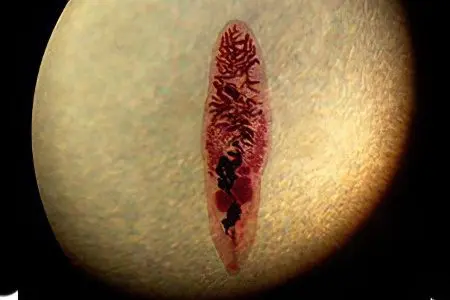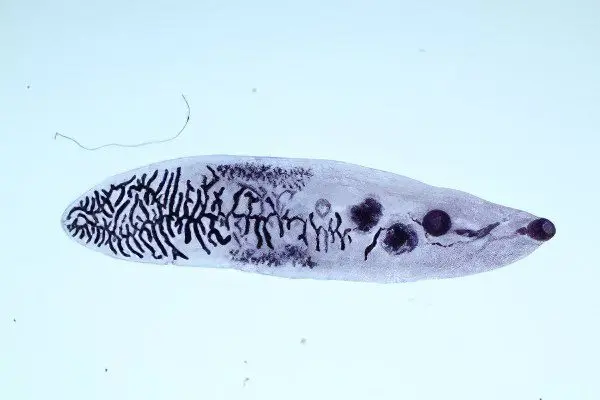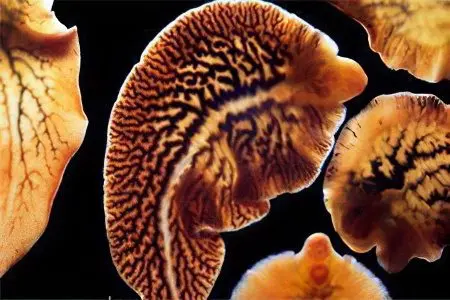Contents
The development cycle of the liver fluke differs depending on the type of worms: liver fluke, lanceolate fluke and liver fluke that causes opisthorchiasis
Development cycle of giant fluke and liver fluke

Adult worms parasitize in the biliary system of a person or animal, secreting eggs that are released into the environment along with the feces of the final host.
When eggs fall into fresh water, larvae (miracidia) emerge from them. They penetrate into the body of gastropods, where they transform into sporocysts, and then into cercariae. After 2 months, cercariae leave the body of the intermediate host and enter the water again. Here they turn into adolescarians, these larvae are ready for the invasion of the final host. It is in this state that they are attached to the water film, or to the surfaces of plants.
After entering the gastrointestinal tract of an animal or a person, the larvae penetrate the walls of the stomach into the abdominal cavity. There they find the liver, penetrate into its parenchyma, reaching the bile ducts.
Sometimes the larvae migrate through the circulatory system, reaching the bile ducts through the portal and intestinal veins. For 3-4 months, the larvae mature in the bile ducts, after which they begin to release eggs into the external environment.
Liver and giant flukes can parasitize in the human body for 10 or more years.
Development cycle of the hepatic fluke causing opisthorchiasis
With the faeces of the final host, which is an animal or a person, the eggs of parasites enter the external environment and enter the reservoir. There they are swallowed by freshwater mollusks, in the body of which the larvae undergo certain changes and turn into cercariae. Two months later, the parasite emerges from the mollusk and independently invades the body of the fish. Worm larvae prefer fish of the carp family.

In the body of the fish, the cercaria sheds its tail and becomes mobile, transforming into a metacercaria. Already after six weeks from being in the body of a fish, the face becomes invasive.
After entering the stomach and upper small intestine of a permanent host (human or animal), the larva enters the gallbladder and liver. The parasite will reach sexual maturity in two weeks. Trematodes are able to exist in the human body from 10 to 30 years, feeding on red blood cells, epithelial cells and mucus secreted by the bile ducts.
The development cycle of the lanceolate fluke

In the body of a permanent host (human or animal), a sexually mature parasite parasitizes, which, together with feces, releases eggs into the external environment. They fall on the soil and are swallowed by terrestrial mollusks. In their body, a cercariae is formed, which goes into the external environment.
The cercariae are eaten by ants and in their body transform into metacercariae. After that, the ants become infectious. When the larvae enter the digestive tract (swallowed along with the ants), they penetrate the bile ducts and gallbladder of the final host, mature there and begin to release eggs into the external environment.
What is the intermediate host of the liver fluke?

The intermediate host of the liver fluke, namely the giant and liver flukes, are gastropods. Most often it is a pond snail of the genus Galba. They live in large numbers in stagnant water bodies, where the water warms up well. It can be low-lying swampy meadows and pastures. Interestingly, there are no molluscs of the species Lamnea truncaltula in Australia, but the liver fluke is quite widespread. The parasite was brought to the territory of the continent with domestic animals and managed to find a new intermediate host, the mollusk L. Tomentosa.
Inside the mollusks, the larvae become sporocysts, and then grow into the stage of tailed cercariae. In the body of gastropods, the liver fluke spends from 1 to 2 months.
A liver fluke that provokes opisthorchiasis requires a change of two intermediate hosts. The first of them is a freshwater mollusk of the genus Bithynia inflate, and the second intermediate host is fish from the carp family (ide, roach, tench, top, etc.).
The intermediate host of the lanceolate fluke is terrestrial mollusks, and after them – ants.









